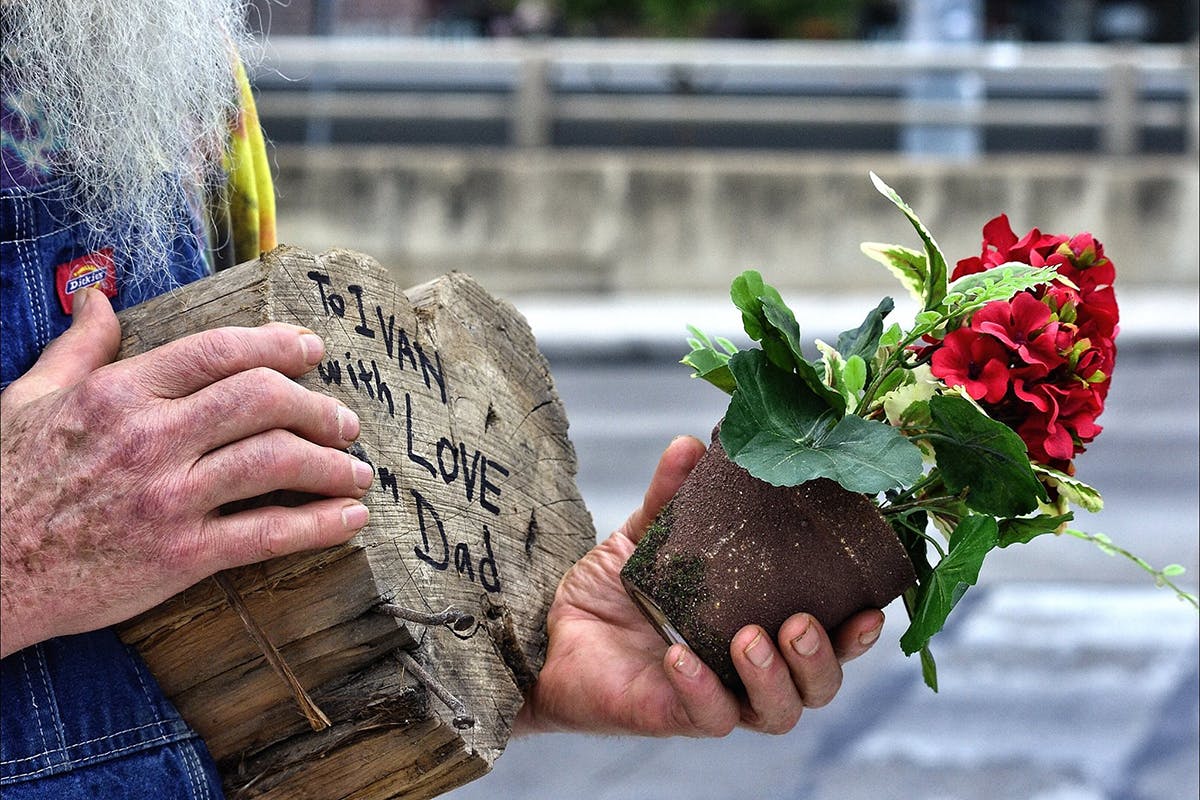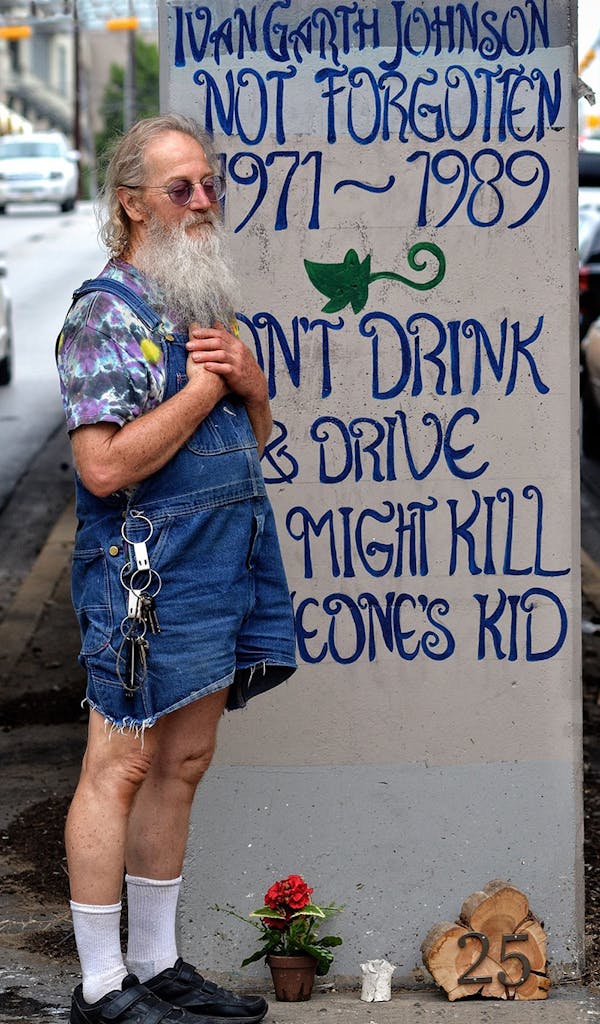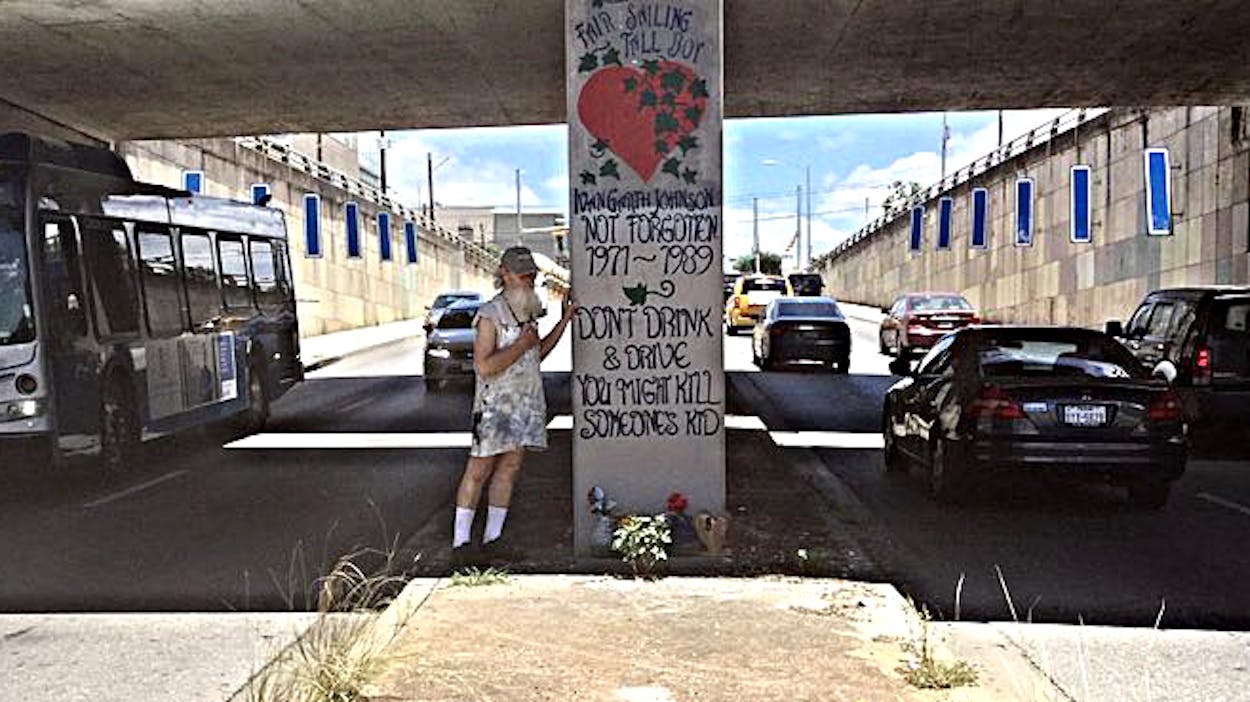Don’t drink and drive, you might kill someone’s kid.
That’s the message Mary Boyd has for drivers passing under North Lamar’s train bridge in Austin. Boyd understands the message firsthand. Years ago, she spray painted it on a pillar in the same spot that seventeen-year-old Ivan Garth Johnson, her only son, was killed in a drunk driving crash.
It was getting dark that Monday evening in July 1989, and Ivan still wasn’t home. He’d been at his dad’s place, and Ivan was always good at letting Boyd know where he was. She would later learn that after Ivan’s car wouldn’t start in the parking lot of a Whataburger, his dad, Bruce David Johnson, had picked him up and towed his car back to his South Austin home to work on it. When Ivan was ready to get back to his mom’s, Bruce David offered to drive him.
But Boyd hadn’t heard from Ivan on that night. Worried, she called around and was eventually patched through to Dottie, Bruce David’s wife. “There was a terrible accident,” Dottie said. “Bruce David is still in surgery.”
“Dottie, how is Ivan?” Boyd asked frantically.
“He didn’t make it, Mary.”
“He’s dead?”
“I’m sorry, Mary.”
Screams tore out of Boyd’s throat. She was stunned. Her only kid was gone. “It’s like getting kicked in the chest,” Boyd says. “You feel it physically.”
Boyd initially felt sorry for the other driver given the seriousness of the accident. But then she learned his blood-alcohol content was over the legal limit. James Storm Shirley, a 25-year-old anthropology student, had been weaving around slower traffic on North Lamar Boulevard when he hit the passenger rear of Bruce David’s car, causing it to spin sideways and slide into a railroad overpass pillar. Bruce David needed brain surgery and was in a coma for five days, Ivan died immediately, and Shirley survived the crash. “People often say you need to forgive, but I have decided that God can forgive him,” Boyd says. “I don’t have to.”
Boyd had her son dressed in a rainbow tie-dye T-shirt and his martial arts uniform for the visitation. On the last day of the visitation, two of her friends and her sister took Boyd to the funeral home where they stayed with Ivan all night, sharing stories. One friend cut the friendship bracelet Ivan wore all the time off his arm and put it on Boyd’s. That night, for the first time, something happened to Boyd that would keep popping up over the next few years. She started to wail. “It was a howl,” Boyd says. “That’s all I can say. I just cried at the top of my lungs.”
She howled for her son, the boy she used to read graphic novels with. Elf Quest was their favorite, and she referred to him as her “elf,” even though he stood six-foot-three-inches tall. Ivan got along with everybody and was almost done with high school, having just taken his GED (after he died, Boyd received a letter saying he passed). And Ivan wanted to fly. His goal was to fly ultralight gliders, but he never had the chance.
Four months after the crash, Boyd grabbed spray paint, stencils, and a friend and headed to the pillar where Ivan died. She had noticed earlier that the column had graffiti on it—a black circle with a slash through it and the number four, which Boyd interpreted to symbolize “for nothing.” “I couldn’t have that,” Boyd says. “I couldn’t have it say for nothing. He didn’t die for nothing.”
While her friend kept watch for cops, Boyd spray-painted a memorial over the graffiti: a red heart covered in ivy leaves—Ivan’s nickname was Ivy—and the words “Fair sailing tall boy” to commemorate his love of flying. Finally, she added: “Don’t drink and drive, you might kill someone’s kid.” Boyd was finishing up the final touches when the cops pulled up. Boyd and her friend were taken to the police station, but after hearing her story the cops were sympathetic and released them.
Every year on the anniversary of the crash, Bruce David, who still lives in South Austin, visits the mural. He survived the crash with various injuries including a brain stem injury causing double vision and a perforation in his right eardrum. When he got out of his coma, before anyone broke the news to him about Ivan, he was already in tears. “My baby, my baby,” he’d cried. Each year he carries flowers and a heart carved from a cedar log bearing the number of years that have passed since that day to the mural. On the back, he writes: “To Ivan, with love, from Dad.” “I feel like I have an obligation to Ivan,” Bruce David says. “I feel that we were together when I was in the coma, and we were helping each other through very difficult transitions. He was leaving this life with no chance, just suddenly.”
Memorabilia of Ivan lies around Bruce David’s home. A shirt with a picture of Ivan’s memorial is hung on the wall, and volumes of journals beginning from 1971, the year Ivan was born, contain memories and photos of him. Twenty-seven years have passed since the accident, more time than he was alive, but Bruce David’s eyes still fill with tears from time to time when he talks about Ivan. “There was a time when I would just start crying spontaneously, just involuntary tears,” he says. “Normally, I’m just moving on with my life.”
Ten years after Boyd painted the memorial, she was driving by and saw that it had been painted over. She called the city to see what happened, and was told the mural had its own file in the Art in Public Places program, a city-wide program that acquires and maintains artwork pertinent the city’s identity. Its erasure was a mistake. She got permission to repaint it, so one Sunday morning she gathered her paint and stencils and headed to the train bridge. As she repainted, people honked and threw up peace signs in support. Some even told her they had been impacted by the memorial and hated to see it gone. Another ten years later, somebody painted over the bottom half. This time, Boyd didn’t have to repaint it herself. A woman she didn’t know stepped up to get it fixed. “I concluded it’s not just mine, it’s not just Ivan’s,” Boyd says. “It belongs to the community.”

In a way, Ivan’s memorial could be a symbol for the entire state. Since November 7, 2000, Texas hasn’t seen a day without a single fatality on its roads. Not all of the 3,500 people who die on average each year on Texas roads die in alcohol-related crashes, but 27 percent of them do. David Glessner of the Texas Department of Transportation says that’s an astonishing number. “Alcohol-related vehicle fatalities are 100 percent preventable,” Glessner says. “That’s what makes them even more difficult to accept because somewhere in that equation someone made the decision to drink and drive.” A study by AxleGeeks showed that in 2015 Texas had a rate of 3.31 alcohol-related fatalities for every 100,000 people, while the national average was 3.06 per 100,000.
December is National Impaired Driving Prevention Month, which is dedicated to raising awareness of the consequences of drunk and drugged driving. During the holidays, Glessner says there is a greater potential for drunk driving because people are often out celebrating and not tied to their usual work schedules. During the 2015-2016 holiday season from December 1, 2015 to January 1, 2016, TxDOT reported 2,374 alcohol-related traffic crashes occurred in Texas, leaving 102 dead and 205 injured. In general, compared to the national average, Texas has a higher rate of drunk driving fatalities.
Glessner says the number of fatalities due to drunk driving varies slightly from year to year. While some years the number of crashes may go down, the number of fatalities might have gone up and vice versa. In 2015, TxDOT reported 960 DUI (alcohol) fatalities, a decrease from the 1,086 reported in 2014. But the 2014 count was up from 1,069 in 2013. “The bottom line in all of this is the number is way too high regardless of what it is,” Glessner says. “These people who are dying out there are somebody’s spouse or child or neighbor.”
So how does a state with the second largest population decrease the number of drunk driving fatalities? Glessner says it comes down to changing people’s behavior, which continues to be a challenge. TxDOT has several initiatives throughout the year such as a program called “Plan While You Can” in which TxDOT goes out to various community events in Texas and allows people to play a virtual game that simulates the effects of drinking. In their “Faces of Drunk Driving” campaign, individuals affected by drunk driving share their stories in front of crowds. This month, Mothers Against Drunk Driving (MADD) will host a series of similar initiatives in Texas that raise awareness such as holiday 5K runs in Austin and Houston.
Much like Boyd did, TxDOT helps individuals affected by drunk driving construct memorials in the form of a roadside sign. The signs say the name of the victim and are accompanied by the message: “Please don’t drink and drive. In memory of…” Since the memorial sign program began in 2007, 173 signs have been installed. Their purpose is two-fold: they’re a way for people to memorialize someone and a public service announcement encouraging people to drive sober. But the signs, unlike Boyd’s tribute, only stay up for two years. “If there wasn’t a time limit on those signs, you could just imagine how many of them there would be over a number of years or decades,” Glessner says. “So the idea is to allow people to pay tribute to loved ones but also to keep our roadways clear.”
MADD has a similar program, in which grieving families can put up a roadside cross to commemorate a lost loved one. Jaime Gutierrez, state executive director of MADD Texas, says this is often an empowering experience for families. “Sometimes they want to be able to say this is how we remember our loved one,” Gutierrez says. “Others, they want it to be a reminder to the public that somebody lost their life here.”

For a while, Boyd couldn’t get herself to let go of Ivan’s ashes. She wanted to spread them somewhere, but wasn’t ready. Then finally, on the tenth anniversary of his death, she decided it was time. Family and friends joined her at Zilker Park, where they reserved a table, brought pictures, and ate food. Suddenly, it started to rain. As others scurried to leave the park, their group stayed. Soon enough, the rain stopped, and the sun was shining. The group went down to the water, and Boyd took the jar with Ivan’s ashes with her. She said a few words about Ivan and poured some of them into the water. They vanished instantly. “They were gone,” Boyd says. “They had become one with Barton Springs.” The group passed the jar around, taking turns sharing memories before pouring the ashes in and watching them disappear. “We all decided Ivan had made it rain, and then made it stop,” Boyd says.
While Ivan’s ashes have long since disappeared into the springs, his story remains unforgotten. His memorial on Lamar is a testament to that. The curly, playful lettering spells out an ultimate truth to each car that passes: “not forgotten.”
Boyd eventually moved to Manor where she lives with her husband, whom she married after Ivan died. As she entered the second decade after the crash, she was able to endure the anniversary without shedding a tear. But then, on the twenty-fifth anniversary, she bawled like a baby. “It never ends,” she says. “It gets way better. It gets to where when you think about Ivan, you think about good things about him, instead of the fact that he died. I still miss him, but he’s not in my life anymore.”
Though no amount of time will eliminate her pain completely, Boyd knows her son’s death was not insignificant. “I don’t think the purpose of his life was to be killed by a drunk driver,” Boyd says. “But I think that’s what his death was about. People need to know and be affected by it. People need to learn.”






